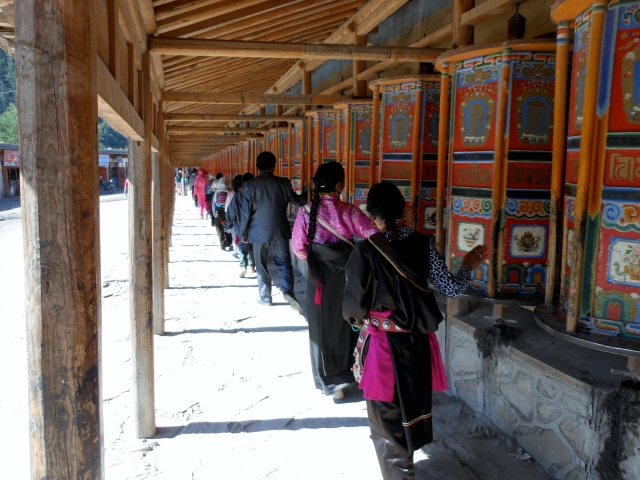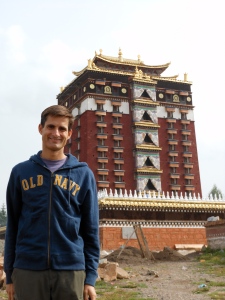Hundreds of kilometres outside of Tibet and still you can find beautiful Tibetan villages and monasteries. Actually, the consensus among travellers is that it is better to visit Tibetan villages outside of Tibet proper, as it is not so much controlled by the Chinese army and visitors can travel independently and talk to people easily.
So, still in the province of Gansu, I visited Labrang Monastery, one of the six great monasteries of the Geluk (Yellow Hat) school of Tibetan Buddhism. It is located in the town of Xiahe, which I really liked for being very laid-back. Here, it really feels like being in Tibet, with Tibetan pilgrims and monks everywhere, Tibetan restaurants, houses, prayer flags, prayer wheels, etc.

Labrang Monastery

Pilgrims running the Kora at Labrang Monastery
While in Xiahe, I received a message from ‘Tom’, whom I had met in Lanzhou, the capital of Gansu. He studies in Lanzhou but was now in his hometown of Hezuo, the capital of Gannan Tibetan Autonomous Prefecture (to which Xiahe belongs), and invited me to visit his city and stay at his place. As it is only a couple of hours bus ride away, I was there by the afternoon.
Tom exemplifies a modern generation of Tibetans in China: very much merged with the Chinese lifestyle but still proud of their own culture. He speaks Tibetan at home with his parents and grandmother. Educated, he also speaks and writes English fluently. Still, with a whole Chinese education, he cannot write his own native language. He is a Buddhist and goes to the temple and runs the Kora when he’s at home, but not as often, as he says he is “busy” with studying (or internet :)). The family lives in a modern, middle-class apartment, far from traditional Tibetan homes, while they also add some Tibetan decor. Most meals are Chinese style, but for breakfast they never miss yak butter tea and tsampa.

Milarepa Monastery
Hezuo also has a famous Tibetan monastery, Milarepa. He took me to visit it. He showed much devotion to all the images inside but couldn’t (or wouldn’t) explain to me much about what they represent. I could remember some of them, though, from my visit to monasteries in Tibet two years ago.
Also here, I ran the ‘Kora’, always clockwise as it is required. Praying wheels contain the sacred scriptures inside, so rolling them is a proxy for reciting, even if one cannot read.

Me running the ‘Kora’
In the evening, we had a great meal in a local restaurant with his cousin, who doesn’t speak a word of English but was very welcoming.

In the Karaoke
And after dinner, the favourite entertainment in this part of the world: Karaoke. Not that I’m a good singer!! With a bottle of Chivas and free flow of beer… They wouldn’t let me pay for anything in my whole stay, no matter how much I insisted.
Finally, Tom received a phone call from his mother: there was no running water in the house. Before I even knew, they had booked and paid a nice hotel room for me, and would pick me up for having breakfast back home.
After lunch, they took me to the bus station and I went back to Lanzhou. After so much kindness, I could only invite the family to visit Spain, although in the knowledge that it is very unlikely that they will ever travel abroad.










